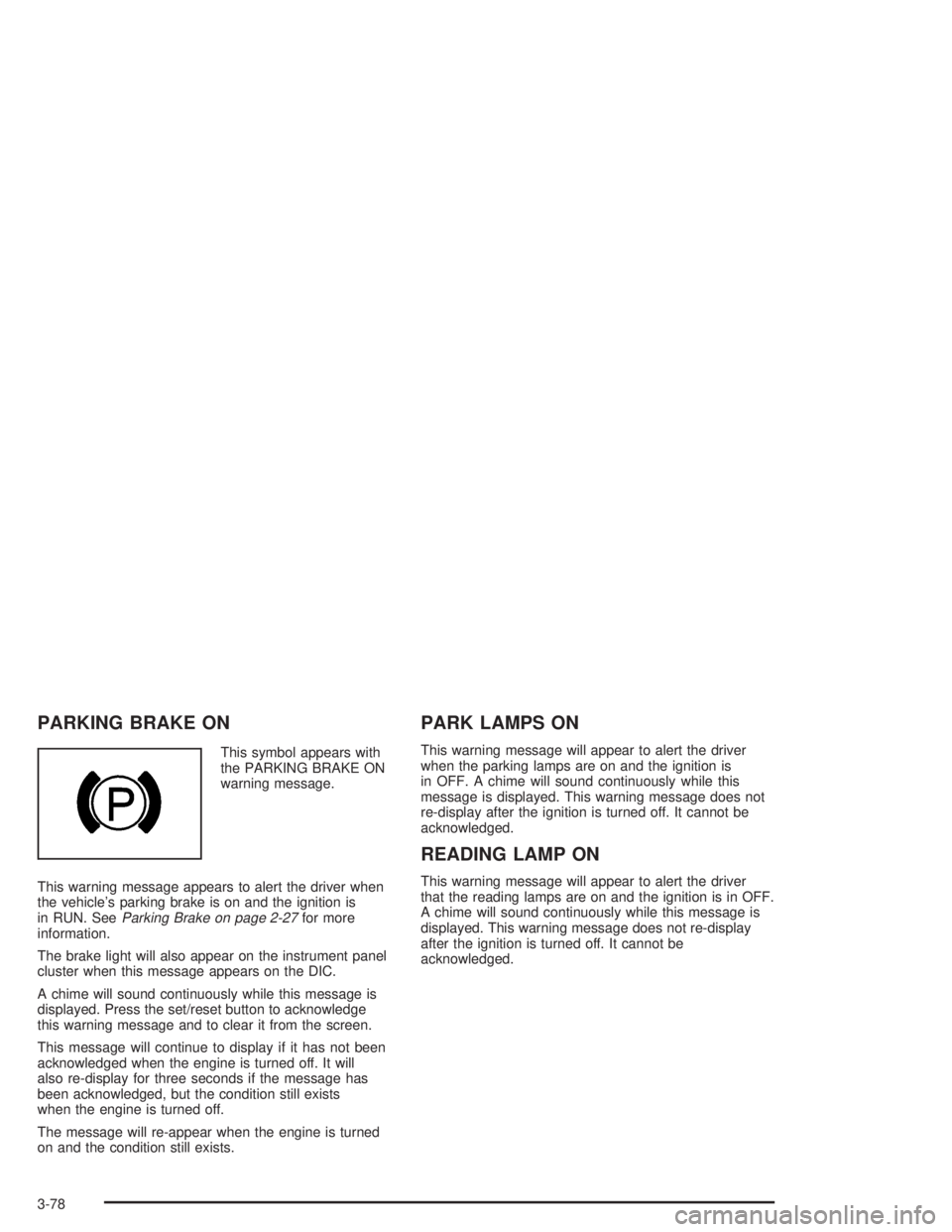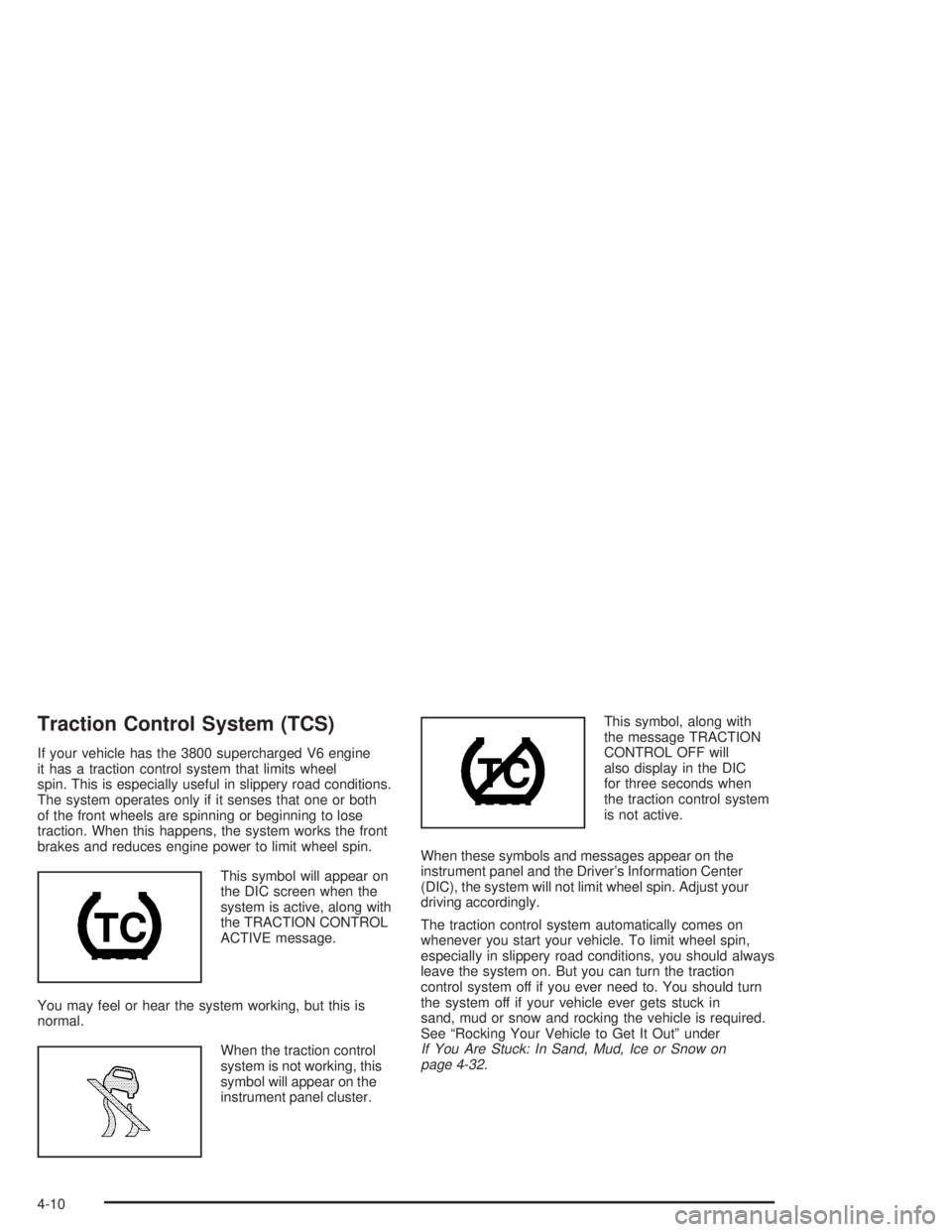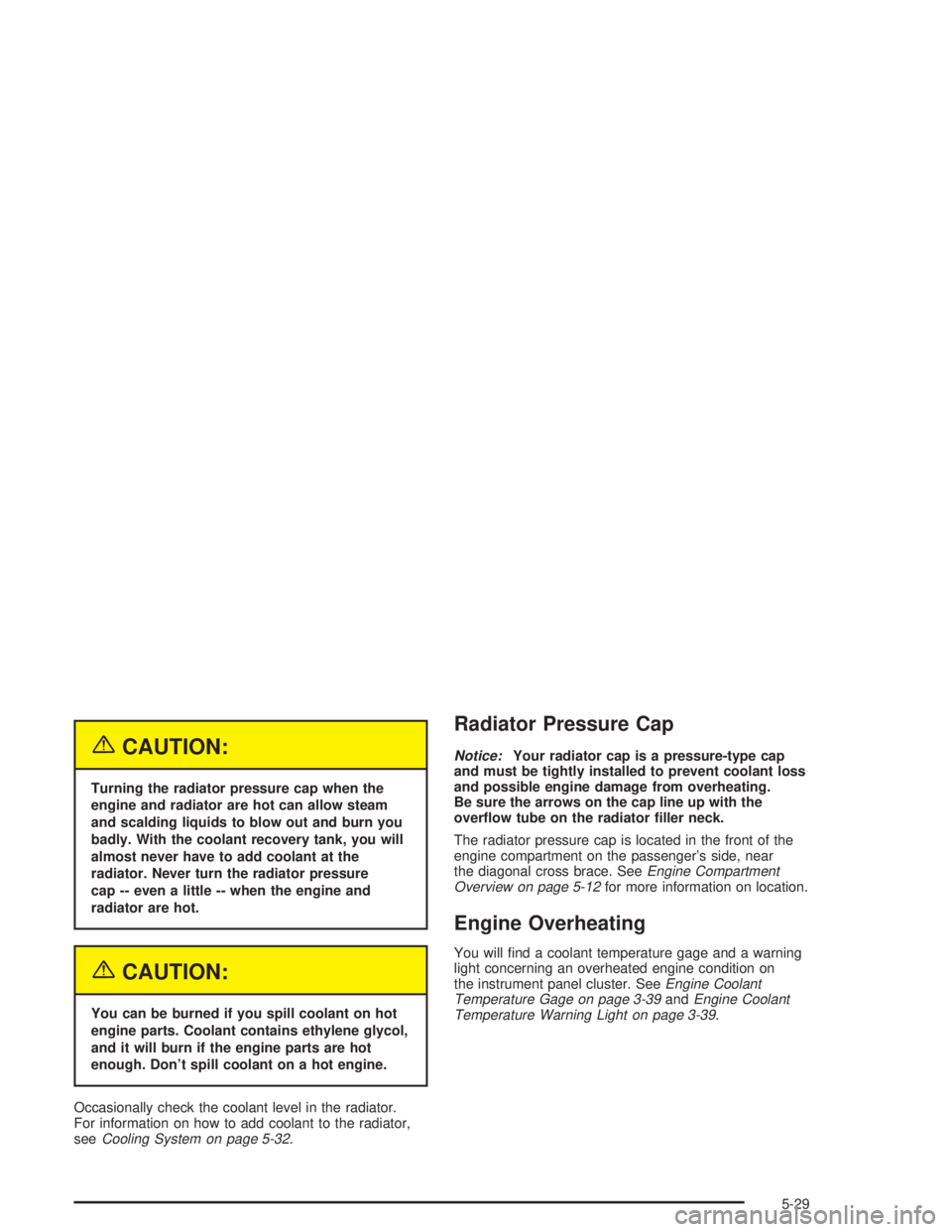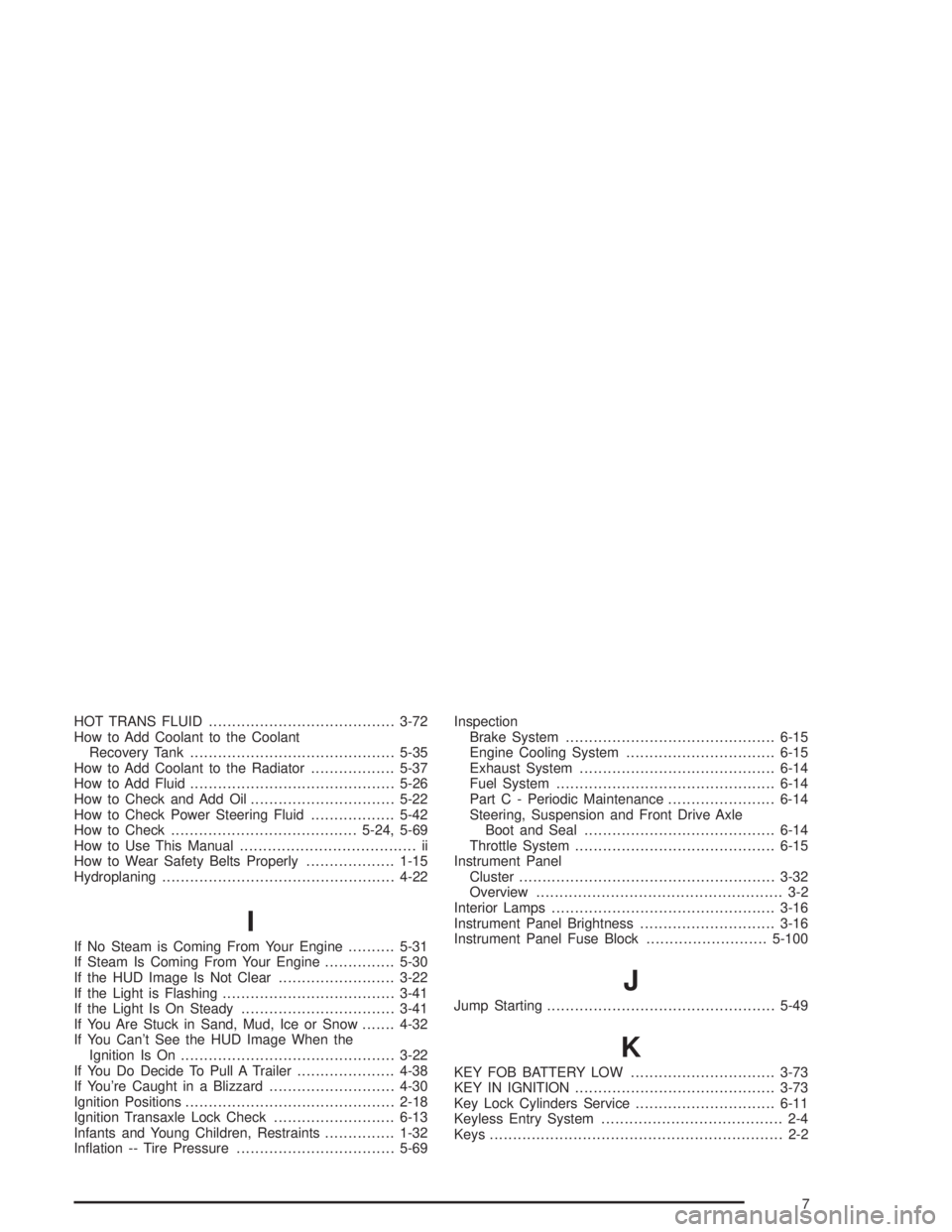2004 PONTIAC GRAND PRIX instrument cluster
[x] Cancel search: instrument clusterPage 161 of 432

5. Press the set/reset button to scroll through the
months of the year, releasing the button when
the correct month appears.
6. Press the options button to advance to the days of
the month.
7. Press the set/reset button to scroll through the days
of the month, releasing the button when the correct
day appears.
8. Press the options button again to advance to the
next screen.
Language:This menu lets you select the language in
which you want the DIC messages to appear. The
DIC can be programmed in one of three languages:
English, French or Spanish. The message on the HUD,
if equipped, will also appear in the language selected.
To change the language use the following procedure:
1. Press the options button until the language you
want the messages to appear on the screen is
displayed.
2. Press the set/reset button to set the language
choice.
3. Press the options button again to advance to the
next screen.Display Units:This menu allows you to choose
whether measurements are displayed in English or
metric units. The messages on the HUD, if equipped,
and the instrument panel cluster will also appear in the
type of measurement selected.
To set the display units function use the following
procedure:
1. Press the set/reset button to select ENGLISH or
METRIC.
2. Press the options button to advance to the next
screen.
DAYTIME DISPLAY ENHANCEMENTS:This menu
allows you to select the color of the display message.
When ON is selected for the daytime enhancement,
the messages will appear black on a red screen. This
combination makes it easier to see the DIC messages
during the daytime. When OFF is selected, or when
the headlamps are on, the messages will appear red on
a black background.
To set the daytime display enhancements function use
the following procedure:
1. Press the set/reset button to select Off or ON.
2. Press the options button to advance to the next
screen.
3-57
Page 174 of 432

HEADLAMPS SUGGESTED
This message appears when the amount of available
light outside the vehicle is low and the exterior
lamps control is off. This message informs the driver
that turning on the exterior lamps is recommended even
though the Daytime Running Lamps (DRL) are still
illuminated and it has become dark enough outside to
require the headlamps and/or other exterior lamps.
This message will display while the ignition is in RUN.
A chime will sound for two seconds when this message
is displayed. Press the set/reset button to acknowledge
this warning message and to clear it from the screen.
This message will continue to display if it has not been
acknowledged when the engine is turned off. It will
also re-display for three seconds if the message has
been acknowledged, but the condition still exists
when the engine is turned off.
The message will re-appear when the engine is turned
on and the condition still exists.
HOT COOLANT
Notice:If the HOT COOLANT warning message
appears on the DIC display, stop the vehicle as soon
as possible. Do not increase the engine speed
above normal idling speed. Severe engine damage
can result from driving a vehicle with an overheated
engine. See ªEngine Overheatingº in the Service
and Appearance Care section for more information.
This symbol will appear
with the HOT COOLANT
warning message.
This warning message will appear while the engine
coolant temperature is too hot. The hot coolant
temperature warning light will also appear on the
instrument panel cluster. Also, the engine coolant
temperature gage will read in the red or ªhotº area.
See
Engine Coolant Temperature Warning Light
on page 3-39andEngine Coolant Temperature Gage
on page 3-39for more information.
3-70
Page 179 of 432

LOW BRAKE FLUID
This symbol appears with
the LOW BRAKE FLUID
warning message.
This warning message will appear when the brake ¯uid
level is low. Fill the brake master cylinder to the proper
level. See
Engine Compartment Overview on page 5-12for the location of the brake master cylinder reservoir.
Also, seeBrakes on page 5-45for proper ¯uid level.
The brake light will also appear on the instrument panel
cluster when this message appears on the DIC.
This warning message will display only when the ignition
is in RUN. A chime will sound continuously while this
message is displayed. Press the set/reset button
to acknowledge this warning message and to clear it
from the screen.
This message will continue to display if it has not been
acknowledged when the engine is turned off. It will
also re-display for three seconds if the message has
been acknowledged, but the condition still exists
when the engine is turned off.
The message will re-appear when the engine is turned
on and the condition still exists.
LOW FUEL
This symbol appears with
the LOW FUEL warning
message.
This warning message will appear when the vehicle is
low on fuel. Re®ll the fuel tank as soon as possible.
This warning message will display while the ignition is
in RUN. A chime will sound for two seconds when
this message is displayed. Press the set/reset button to
acknowledge this warning message and to clear it
from the screen.
This message will continue to display if it has not been
acknowledged when the engine is turned off. It will
also re-display for three seconds if the message has
been acknowledged, but the condition still exists
when the engine is turned off.
The message will re-appear when the engine is turned
on and the condition still exists.
3-75
Page 182 of 432

PARKING BRAKE ON
This symbol appears with
the PARKING BRAKE ON
warning message.
This warning message appears to alert the driver when
the vehicle's parking brake is on and the ignition is
in RUN. See
Parking Brake on page 2-27for more
information.
The brake light will also appear on the instrument panel
cluster when this message appears on the DIC.
A chime will sound continuously while this message is
displayed. Press the set/reset button to acknowledge
this warning message and to clear it from the screen.
This message will continue to display if it has not been
acknowledged when the engine is turned off. It will
also re-display for three seconds if the message has
been acknowledged, but the condition still exists
when the engine is turned off.
The message will re-appear when the engine is turned
on and the condition still exists.
PARK LAMPS ON
This warning message will appear to alert the driver
when the parking lamps are on and the ignition is
in OFF. A chime will sound continuously while this
message is displayed. This warning message does not
re-display after the ignition is turned off. It cannot be
acknowledged.
READING LAMP ON
This warning message will appear to alert the driver
that the reading lamps are on and the ignition is in OFF.
A chime will sound continuously while this message is
displayed. This warning message does not re-display
after the ignition is turned off. It cannot be
acknowledged.
3-78
Page 246 of 432

Traction Control System (TCS)
If your vehicle has the 3800 supercharged V6 engine
it has a traction control system that limits wheel
spin. This is especially useful in slippery road conditions.
The system operates only if it senses that one or both
of the front wheels are spinning or beginning to lose
traction. When this happens, the system works the front
brakes and reduces engine power to limit wheel spin.
This symbol will appear on
the DIC screen when the
system is active, along with
the TRACTION CONTROL
ACTIVE message.
You may feel or hear the system working, but this is
normal.
When the traction control
system is not working, this
symbol will appear on the
instrument panel cluster.This symbol, along with
the message TRACTION
CONTROL OFF will
also display in the DIC
for three seconds when
the traction control system
is not active.
When these symbols and messages appear on the
instrument panel and the Driver's Information Center
(DIC), the system will not limit wheel spin. Adjust your
driving accordingly.
The traction control system automatically comes on
whenever you start your vehicle. To limit wheel spin,
especially in slippery road conditions, you should always
leave the system on. But you can turn the traction
control system off if you ever need to. You should turn
the system off if your vehicle ever gets stuck in
sand, mud or snow and rocking the vehicle is required.
See ªRocking Your Vehicle to Get It Outº under
If You Are Stuck: In Sand, Mud, Ice or Snow on
page 4-32.
4-10
Page 309 of 432

{CAUTION:
Turning the radiator pressure cap when the
engine and radiator are hot can allow steam
and scalding liquids to blow out and burn you
badly. With the coolant recovery tank, you will
almost never have to add coolant at the
radiator. Never turn the radiator pressure
cap -- even a little -- when the engine and
radiator are hot.
{CAUTION:
You can be burned if you spill coolant on hot
engine parts. Coolant contains ethylene glycol,
and it will burn if the engine parts are hot
enough. Don't spill coolant on a hot engine.
Occasionally check the coolant level in the radiator.
For information on how to add coolant to the radiator,
see
Cooling System on page 5-32.
Radiator Pressure Cap
Notice:Your radiator cap is a pressure-type cap
and must be tightly installed to prevent coolant loss
and possible engine damage from overheating.
Be sure the arrows on the cap line up with the
over¯ow tube on the radiator ®ller neck.
The radiator pressure cap is located in the front of the
engine compartment on the passenger's side, near
the diagonal cross brace. See
Engine Compartment
Overview on page 5-12for more information on location.
Engine Overheating
You will ®nd a coolant temperature gage and a warning
light concerning an overheated engine condition on
the instrument panel cluster. See
Engine Coolant
Temperature Gage on page 3-39andEngine Coolant
Temperature Warning Light on page 3-39.
5-29
Page 423 of 432

HOT TRANS FLUID........................................3-72
How to Add Coolant to the Coolant
Recovery Tank............................................5-35
How to Add Coolant to the Radiator..................5-37
How to Add Fluid............................................5-26
How to Check and Add Oil...............................5-22
How to Check Power Steering Fluid..................5-42
How to Check........................................5-24, 5-69
How to Use This Manual...................................... ii
How to Wear Safety Belts Properly...................1-15
Hydroplaning..................................................4-22
I
If No Steam is Coming From Your Engine..........5-31
If Steam Is Coming From Your Engine...............5-30
If the HUD Image Is Not Clear.........................3-22
If the Light is Flashing.....................................3-41
If the Light Is On Steady.................................3-41
If You Are Stuck in Sand, Mud, Ice or Snow.......4-32
If You Can't See the HUD Image When the
Ignition Is On..............................................3-22
If You Do Decide To Pull A Trailer.....................4-38
If You're Caught in a Blizzard...........................4-30
Ignition Positions.............................................2-18
Ignition Transaxle Lock Check..........................6-13
Infants and Young Children, Restraints...............1-32
In¯ation -- Tire Pressure..................................5-69Inspection
Brake System.............................................6-15
Engine Cooling System................................6-15
Exhaust System..........................................6-14
Fuel System...............................................6-14
Part C - Periodic Maintenance.......................6-14
Steering, Suspension and Front Drive Axle
Boot and Seal.........................................6-14
Throttle System...........................................6-15
Instrument Panel
Cluster.......................................................3-32
Overview..................................................... 3-2
Interior Lamps................................................3-16
Instrument Panel Brightness.............................3-16
Instrument Panel Fuse Block..........................5-100
J
Jump Starting.................................................5-49
K
KEY FOB BATTERY LOW...............................3-73
KEY IN IGNITION...........................................3-73
Key Lock Cylinders Service..............................6-11
Keyless Entry System....................................... 2-4
Keys............................................................... 2-2
7